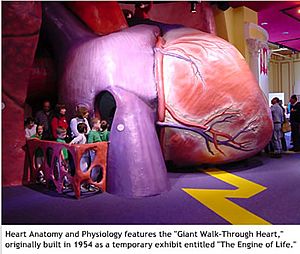The Giant Heart facts for kids
The Giant Heart exhibit is one of the most famous and popular attractions at the Franklin Institute in Philadelphia. It was built in 1953 and was first called the "Engine of Life." This amazing exhibit is about two stories tall and 35 feet wide. Visitors can actually walk through it to explore the different parts of the heart. For many students in the Philadelphia area, visiting The Giant Heart on a field trip is a special tradition.
History of the Giant Heart
The idea for a walk-through heart exhibit came from Dr. Mildred Pfeiffer. She was a physician who taught people about the heart and staying healthy. Dr. Pfeiffer wanted a central place where everyone could learn about the heart. She designed The Giant Heart with a medical artist and an engineer.
The first Giant Heart was made from simple materials like papier-mâché, chicken wire, and lumber. It was only supposed to be on display for six months. But it became so popular that the Franklin Institute decided to keep it. More than 70 years later, it is still one of the most visited exhibits there.
What You See Inside the Giant Heart
The Giant Heart is huge! It is 100 times bigger than a normal human heart. As you walk through it, signs point out which part of the "heart" you are in. This helps you understand how a real heart works.
The deeper you go into the exhibit, the louder you hear a heartbeat sound. This sound was first made by a computer. But during updates in 2019, it was changed to the sound of a real human heartbeat. This makes the experience even more realistic.
Next to The Giant Heart, you can find the Bio-science exhibit. This area helps visitors learn even more about the human body and how it functions.
Updates and Changes
Over the years, The Giant Heart has been updated several times. In 1979, the exhibit was rebuilt using stronger fiberglass materials. It was also given new looks and features in 2004 and again in 2019. These updates help keep the exhibit exciting and educational for new generations of visitors.


